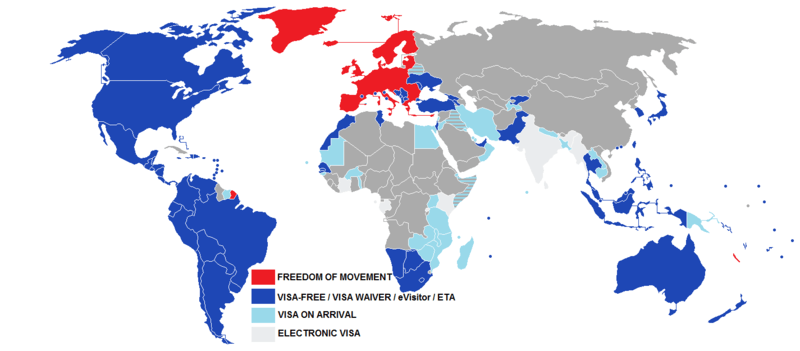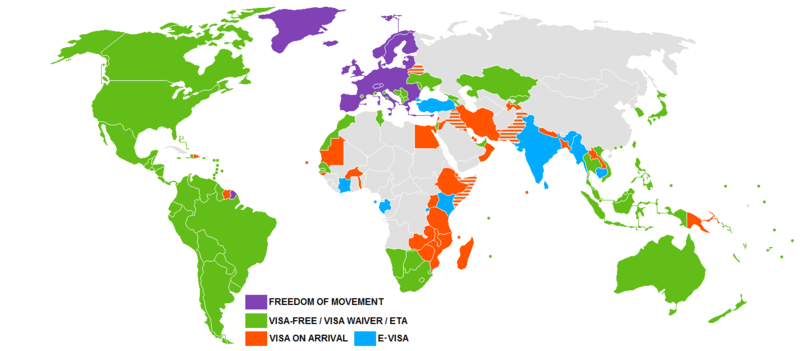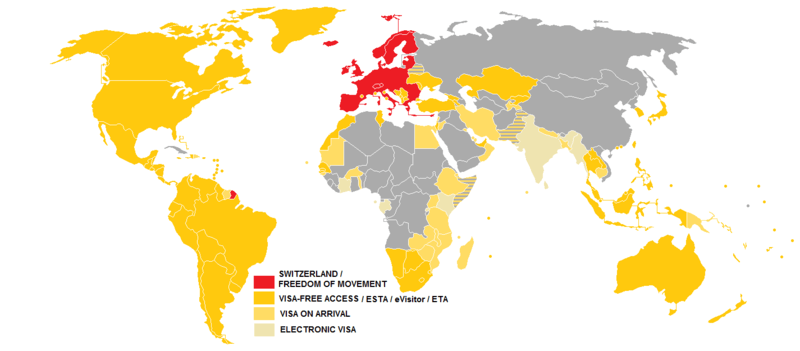European Free Trade Association
| European Free Trade Association |
||||
|---|---|---|---|---|
|
||||
 Location of the EFTA (green) in Europe (green & dark grey) |
||||
| Secretariat | Geneva 46°57′N 7°27′E / 46.950°N 7.450°E | |||
| Largest city | Oslo 59°56′N 10°41′E / 59.933°N 10.683°E | |||
| Official working language |
English | |||
| Official languages of member states |
||||
| Type | Regional organisation, free trade area | |||
| Member states | ||||
| Leaders | ||||
| • | Secretary General | Kristinn F. Árnason | ||
| • | Council Chair | Iceland | ||
| Establishment | ||||
| • | Convention signed | 4 January 1960 | ||
| • | Established | 3 May 1960 | ||
| Area | ||||
| • | Total | 529,600 km2 204,518 sq mi |
||
| Population | ||||
| • | 2012 estimate | 13,589,956 | ||
| • | Density | 100.6/km2 59.82/sq mi |
||
| GDP (PPP) | 2011 IMF estimate | |||
| • | Total | $623.5 billion | ||
| • | Per capita | $44,828 | ||
| GDP (nominal) | 2011 IMF estimate | |||
| • | Total | $1138.8 billion | ||
| • | Per capita | $58,714 | ||
| Currency | ||||
| Time zone | WET (UTC) CET (UTC+1) |
|||
| • | Summer (DST) | CEST (UTC+2) | ||
| Note: Iceland observes WET all year, while Liechtenstein, Norway, and Switzerland observe CET and CEST. | ||||
| Website efta |
||||
The European Free Trade Association (EFTA) is a regional trade organisation and free trade area consisting of four European states: Iceland, Liechtenstein, Norway, and Switzerland.[1] The organisation operates in parallel with the European Union (EU), and all four member states participate in the EU's single market.[2]
The EFTA was established on 3 May 1960 as an alternative trade bloc for European states who were unable or unwilling to join the then European Economic Community (EEC) (which subsequently became the EU). The Stockholm Convention, establishing EFTA, was signed on 4 January 1960 in the Swedish capital by seven countries (known as the "outer seven"). Today only two founding members remain: Norway and Switzerland. The other five were Austria, Denmark, Portugal, Sweden and the United Kingdom. The initial Stockholm Convention was superseded by the Vaduz Convention, with the aim of providing a successful framework for continued expansion and liberalization of trade among the organisation's member states and with the rest of the world.
While the EFTA is not a customs union and member states have full rights to enter into bilateral third-country trade arrangements, it does have a co-ordinated trade policy.[1] As a result, its member states have jointly concluded free trade agreements with a number of other countries.[1] To participate in the EU's single market, Iceland, Liechtenstein and Norway are party to the Agreement on a European Economic Area (EEA), with compliance regulated by the EFTA Surveillance Authority and the EFTA Court. Switzerland instead has a set of bilateral agreements with the EU.
History
British reaction to the creation of the European Economic Community was mixed and complex. Britain was also preoccupied with the Commonwealth, which, at the time of EFTA's formation, was in transition. Britain therefore brought together several countries, including some bordering the EEC, to form the European Free Trade Association soon after the establishment of the six-nation EEC (France, West Germany, Italy, Belgium, Luxembourg, and the Netherlands).
On 12 January 1960, the Treaty on European Free Trade Association was initialled in the Golden Hall of the Prince's Palace of Stockholm. This established the progressive elimination of customs duties on industrial products, but did not affect agricultural products or maritime trade.
The main difference between the early EEC and the EFTA was the absence of a common external customs tariff, and therefore each EFTA member was free to establish individual customs duties against, or individual free trade agreements with, non-EFTA countries. Despite this modest initiative, the financial results were excellent, as it stimulated an increase of foreign trade volume among its members from 3.5 to 8.2 billion US dollars between 1959 and 1967. This was rather less than the increase enjoyed by countries inside the EEC.
After the accession of Denmark, Ireland and the UK to the EEC in January 1973, EFTA began to falter. For this reason most countries eased or eliminated their trade tariffs in preparation to join the EEC, but experienced declining revenue which reduced the importance of EFTA. Four members remain: Switzerland, Norway, Liechtenstein and Iceland.
The interactive Free Trade Map gives an overview of partners worldwide.[3]
Portugal Fund
The Portugal Fund was established in 1975 when Portugal was still a member of EFTA, to provide funding for the development and reconstruction of Portugal after the Carnation Revolution. When Portugal left EFTA in 1985 to join the EEC, the remaining EFTA members decided to continue the Portugal Fund, so that Portugal would continue to benefit from it. The Fund originally took the form of a low-interest loan from the EFTA member states to Portugal, to the value of $US 100 million. Repayment was originally to commence in 1988, but EFTA then decided to postpone the start of repayments until 1998. The Portugal Fund has now been dissolved by the Member States.
Membership
History
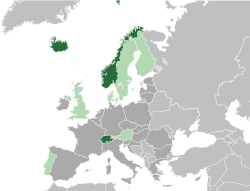
The founding members of EFTA were Austria, Denmark, Norway, Portugal, Sweden, Switzerland and the United Kingdom. During the 1960s these countries were often referred to as the Outer Seven, as opposed to the Inner Six of the then-European Economic Community (EEC).[4]
Finland became an associate member in 1961 and a full member in 1986, and Iceland joined in 1970. The United Kingdom and Denmark joined the EEC in 1973, and hence ceased to be EFTA members. Portugal also left EFTA for the European Community in 1986. Liechtenstein joined EFTA in 1991 (previously its interests had been represented by Switzerland). Austria, Sweden and Finland joined the EU in 1995 and thus ceased to be EFTA members.
Twice, in 1973 and 1995, the Norwegian government has tried to join the EU (still the EEC in 1973) and by doing so, leave the EFTA. Both times, membership of the EU was rejected in national referenda, keeping Norway in the EFTA. Iceland applied for EU membership in 2009 due to the 2008–2011 Icelandic financial crisis, but has since dropped its bid.[5]
Current members
| Contracting party | Accession | Population | Area (km²) | Capital | GDP in millions (PPP)[6] | GDP per capita (PPP)[6] |
|---|---|---|---|---|---|---|
| |
1 January 1970 | 332,600 | 103,000 | Reykjavík | 12,831[7] | 39,223[7] |
| |
1 January 1991 | 37,800 | 160.4 | Vaduz | 3,545[8] | 98,432[8] |
| |
3 May 1960 | 5,242,000 | 385,155 | Oslo | 265,911[9] | 53,470[9] |
| |
3 May 1960 | 8,345,000 | 41,285 | Bern | 363,421[10] | 45,417[10] |
Former members
| State | Accession | Left EFTA and joined EU/EEC |
|---|---|---|
| 1960 | 1995 | |
| 1960 | 1973 | |
| 1986 | 1995 | |
| 1960 | 1986 | |
| 1960 | 1995 | |
| 1960 | 1973 |
Future

EFTA (green)
Between 1994 and 2011, EFTA membership for Andorra, San Marino, Monaco, the Isle of Man, Turkey, Israel, Morocco and other EU 'European Neighbourhood Policy' partners was discussed.[11]
Microstates
In November 2012, after the Council of the European Union had called for an evaluation of the EU's relations with the sovereign European microstates of Andorra, Monaco and San Marino, which they described as "fragmented",[12] the European Commission published a report outlining options for their further integration into the EU.[13] Unlike Liechtenstein, which is a member of the EEA via the EFTA and the Schengen Agreement, relations with these three states are based on a collection of agreements covering specific issues. The report examined four alternatives to the current situation:
- a Sectoral Approach with separate agreements with each state covering an entire policy area,
- a comprehensive, multilateral Framework Association Agreement (FAA) with the three states,
- EEA membership, and
- EU membership.
The Commission argued that the sectoral approach did not address the major issues and was still needlessly complicated, while EU membership was dismissed in the near future because "the EU institutions are currently not adapted to the accession of such small-sized countries". The remaining options, EEA membership and a FAA with the states, were found to be viable and were recommended by the Commission. In response, the Council requested that negotiations with the three microstates on further integration continue, and that a report be prepared by the end of 2013 detailing the implications of the two viable alternatives and recommendations on how to proceed.[14]
As EEA membership is currently only open to EFTA or EU members, the consent of existing EFTA member states is required for the microstates to join the EEA without becoming members of the EU. In 2011, Jonas Gahr Støre, the then Foreign Minister of Norway which is an EFTA member state, said that EFTA/EEA membership for the microstates was not the appropriate mechanism for their integration into the internal market due to their different requirements from those of large countries such as Norway, and suggested that a simplified association would be better suited for them.[15] Espen Barth Eide, Støre's successor, responded to the Commission's report in late 2012 by questioning whether the microstates have sufficient administrative capabilities to meet the obligations of EEA membership. However, he stated that Norway was open to the possibility of EFTA membership for the microstates if they decide to submit an application, and that the country had not made a final decision on the matter.[16][17][18][19] Pascal Schafhauser, the Counsellor of the Liechtenstein Mission to the EU, said that Liechtenstein, another EFTA member state, was willing to discuss EEA membership for the microstates provided their joining did not impede the functioning of the organization. However, he suggested that the option direct membership in the EEA for the microstates, outside of both the EFTA and the EU, should be given consideration.[18] On 18 November 2013 the EU Commission concluded that "the participation of the small-sized countries in the EEA is not judged to be a viable option at present due to the political and institutional reasons", and that Association Agreements were a more feasible mechanism to integrate the microstates into the internal market.[20]
Norway
The Norwegian electorate has rejected treaties of accession to the EU in two referendums. At the time of the first referendum in 1972, their neighbour Denmark joined. Following the second referendum in 1994, two other Nordic neighbours, Sweden and Finland, joined the EU. The last two governments of Norway have been unable and unwilling to advance the question positively, as they have both been coalition governments consisting of proponents and opponents.
Switzerland
Since Switzerland rejected EEA membership in a referendum in 1992, more referendums on EU membership have been initiated, the last time in 2001. These were all rejected.
Iceland
On 16 July 2009, the government of Iceland formally applied for EU membership,[21] but the negotiation process has been halted since mid-2013.
Faroe Islands
In mid-2005, representatives of the Faroe Islands raised the possibility of their territory joining the EFTA.[22] According to Article 56 of the EFTA Convention, only states may become members of the EFTA.[23] The Faroes are a constituent country of the Kingdom of Denmark, and not a sovereign state in their own right.[24] Consequently, they considered the possibility that the "Kingdom of Denmark in respect of the Faroes" could join the EFTA, though the Danish Government has stated that this mechanism would not allow the Faroes to become a separate member of the EEA because Denmark was already a party to the EEA Agreement.[24]
The Faroes already have an extensive bilateral free trade agreement with Iceland, known as the Hoyvík Agreement.
United Kingdom
The United Kingdom was a co-founder of EFTA in 1960, but ceased to be a member upon joining the European Union. The country held a referendum in 2016 on withdrawing from the EU (popularly referred to as "Brexit"), resulting in a 52% vote in favour of withdrawing. While, the referendum result is only advisory, the UK Government has indicated it intends to follow the result. A 2013 research paper presented to the Parliament of the United Kingdom proposed a number of alternatives to EU membership which would continue to allow it access to the EU's internal market, including continuing EEA membership as an EFTA member state, or the Swiss model of a number of bilateral treaties covering the provisions of the single market.[25]
In the first meeting since the Brexit vote, EFTA reacted by saying both that they were open to a UK return and that Britain has many issues to work through. The president of Switzerland Johann Schneider-Ammann stated that its return would strengthen the association.[26] However, in August 2016 the Norwegian Government expressed reservations. Norway's European affairs minister, Elisabeth Vik Aspaker, told the Aftenposten newspaper: "It’s not certain that it would be a good idea to let a big country into this organisation. It would shift the balance, which is not necessarily in Norway’s interests".[27]
Scotland
Given the United Kingdom's referendum vote in favour of leaving the European Union and Scotland's substantial majority in favour of remaining within the European Union, the Scottish Government has been looking into methods to retain access to or membership of the Single Market; consequently membership of the EFTA is another option the Scottish government is analysing. It is currently unclear if Scotland would have to become independent for such membership, or if it would require agreement with the United Kingdom Government and the Governments of the EFTA members.[28]
Organisation
EFTA is governed by the EFTA Council and serviced by the EFTA Secretariat. In addition, in connection with the EEA Agreement of 1992, two other EFTA organisations were established, the EFTA Surveillance Authority and the EFTA Court.
Council
The EFTA Council is the highest governing body of EFTA. The Council usually meets eight times a year at the ambassadorial level (heads of permanent delegations to EFTA) and twice a year at Ministerial level. In the Council meetings, the delegations consult with one another, negotiate and decide on policy issues regarding EFTA. Each Member State is represented and has one vote, though decisions are usually reached through consensus.
The Council discusses substantive matters, especially relating to the development of EFTA relations with third countries and the management of free trade agreements, and keeps under general review relations with the EU third-country policy and administration. It has a broad mandate to consider possible policies to promote the overall objectives of the Association and to facilitate the development of links with other states, unions of states or international organisations. The Council also manages relations between the EFTA States under the EFTA Convention. Questions relating to the EEA are dealt with by the Standing Committee in Brussels.
Secretariat
The day-to-day running of the Secretariat is headed by the Secretary-General, Kristinn F. Árnason, who is assisted by two Deputy Secretaries-General, one based in Geneva and the other in Brussels. The three posts are shared between the Member States. The division of the Secretariat reflects the division of EFTA’s activities. The Secretariat employs approximately 100 staff members, of whom a third are based in Geneva and two thirds in Brussels and Luxembourg.
The Headquarters in Geneva deals with the management and negotiation of free trade agreements with non-EU countries, and provide support to the EFTA Council.
In Brussels, the Secretariat provides support for the management of the EEA Agreement and assists the Member States in the preparation of new legislation for integration into the EEA Agreement. The Secretariat also assists the Member States in the elaboration of input to EU decision making.
The two duty stations work together closely to implement the Vaduz Convention’s stipulations on the intra-EFTA Free Trade Area.
The EFTA Statistical Office in Luxembourg contributes to the development of a broad and integrated European Statistical System. The EFTA Statistical Office (ESO) is located in the premises of Eurostat, the Statistical Office of the European Union, in Luxembourg, and functions as a liaison office between Eurostat and the EFTA National Statistical Institutes. ESO's main objective is to promote the full inclusion of the EFTA States in the European Statistical System, thus providing harmonised and comparable statistics to support the general cooperation process between EFTA and the EU within and outside the EEA Agreement. The cooperation also entails technical cooperation programmes with third countries and training of European statisticians.
EEA institutions
A Joint Committee consisting of the EEA States plus the European Commission (representing the EU) has the function of extending relevant EU law to the non EU members. An EEA Council meets twice yearly to govern the overall relationship between the EEA members.
Rather than setting up pan-EEA institutions, the activities of the EEA are regulated by the EFTA Surveillance Authority and the EFTA Court. The EFTA Surveillance Authority and the EFTA Court regulate the activities of the EFTA members in respect of their obligations in the European Economic Area (EEA). Since Switzerland is not an EEA member, it does not participate in these institutions.
The EFTA Surveillance Authority performs the European Commission's role as "guardian of the treaties" for the EFTA countries, while the EFTA Court performs the European Court of Justice's role for those countries.
The original plan for the EEA lacked the EFTA Court or the EFTA Surveillance Authority, the European Court of Justice and the European Commission were to exercise those roles. However, during the negotiations for the EEA agreement, the European Court of Justice informed the Council of the European Union by way of letter that they considered that giving the EU institutions powers with respect to non-EU member states would be a violation of the treaties, and therefore the current arrangement was developed instead.
Norway Grants
The EEA and Norway Grants are the financial contributions of Iceland, Liechtenstein and Norway to reduce social and economic disparities in Europe. They were established in conjunction with the 2004 enlargement of the European Economic Area (EEA), which brought together the EU, Iceland, Liechtenstein and Norway in the Internal Market. In the period from 2004 to 2009, €1.3 billion of project funding was made available for project funding in the 15 beneficiary states in Central and Southern Europe. The EEA and Norway Grants are administered by the Financial Mechanism Office, which is affiliated to the EFTA Secretariat in Brussels.
Locations
The EFTA Secretariat is headquartered in Geneva, Switzerland, but also has duty stations in Brussels, Belgium and Luxembourg City, Luxembourg. The EFTA Surveillance Authority has its headquarters in Brussels, Belgium (the same location as the headquarters of the European Commission), while the EFTA Court has its headquarters in Luxembourg City (the same location as the headquarters of the European Court of Justice).
Relationship with the European Union
Except for Switzerland, the EFTA members are also members of the European Economic Area (EEA). The EEA comprises three member states of the European Free Trade Association (EFTA) and 28 member states of the European Union (EU), including Croatia which is provisionally applying the agreement pending its ratification by all EEA countries.[29][30] It was established on 1 January 1994 following an agreement with the European Community (which had become the EU two months earlier).[31] It allows the EFTA-EEA states to participate in the EU's Internal Market without being members of the EU. They adopt almost all EU legislation related to the single market, except laws on agriculture and fisheries. However, they also contribute to and influence the formation of new EEA relevant policies and legislation at an early stage as part of a formal decision-shaping process.[32] One EFTA member, Switzerland, has not joined the EEA but has a series of bilateral agreements, including a free trade agreement, with the EU.
The following table summarises the various components of EU laws applied in the EFTA countries and their sovereign territories. Some territories of EU member states also have a special status in regard to EU laws applied as is the case with some European microstates.
| EFTA member states and territories | Application of EU law | EURATOM | European Defence Agency | Schengen area | EU VAT area | EU customs territory | EU single market | Eurozone | |
|---|---|---|---|---|---|---|---|---|---|
| |
Partial | No | No | Yes | No | No | Yes[33] | No, ISK | |
| |
Partial | No | No | Yes | No, Swiss–Liechtenstein VAT area | No, Swiss–Liechtenstein customs territory | Yes[33] | No, CHF | |
| |
Partial | No | Participating non‑member state | Yes | No | No | Yes[33] | No, NOK | |
| Partial | No | No | No[34] | No, VAT free[35] | No | No[33][36][37] | No, NOK | ||
| |
Partial | Participating associated state[38] | No | Yes | No, Swiss–Liechtenstein VAT area | No, Swiss–Liechtenstein customs territory | Yes[39] | No, CHF | |
| Partial | Participating associated state[38] | No | Yes | No, VAT free | No, Swiss–Liechtenstein customs territory | Yes[39] | No, CHF | ||

International conventions
EFTA also originated the Hallmarking Convention and the Pharmaceutical Inspection Convention, both of which are open to non-EFTA states.
International trade relations
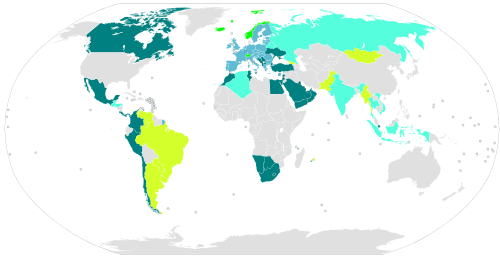
EFTA has several free trade agreements with non-EU countries as well as declarations on cooperation and joint workgroups to improve trade. Currently, the EFTA States have established preferential trade relations with 24 states and territories, in addition to the 28 member states of the European Union.[40]
Free trade agreements
- Albania
- Bosnia-Herzegovina[41]
- Canada (Canada-European Free Trade Association Free Trade Agreement)
- Central American States (Costa Rica, Panama)[41]
- Chile
- Colombia
- Egypt
- Gulf Co-operation Council (Bahrain, Kuwait, Oman, Qatar, Saudi Arabia, United Arab Emirates)[42]
- Hong Kong (China)
- Israel
- Jordan
- South Korea
- Lebanon
- Macedonia
- Mexico
- Montenegro
- Morocco (excluding Western Sahara)[43]
- Palestinian National Authority
- Peru
- Serbia
- Singapore
- Southern African Customs Union (Botswana, Lesotho, Namibia, South Africa, Swaziland)
- Tunisia
- Turkey
- Ukraine[44]
Ongoing free trade negotiations
Declarations on cooperation or dialogue on closer trade relations
Travel policies
Free movement of people within the EEA
A citizen of an EFTA country can live and work in all other EFTA countries and in all EU countries, and a citizen of an EU country can live and work in all EFTA countries (but for voting and working in sensitive fields, such as government / police / military, citizenship is often required, and non-citizens may not have the same rights to welfare and unemployment benefits as citizens).
Dual citizenship
Since each EFTA and EU country can make its own citizenship laws, dual citizenship is not always possible. Of the EFTA countries, Iceland and Switzerland allow it (in Switzerland, conditions for the naturalization of immigrants vary regionally), but Norway only in exceptional cases, and Liechtenstein only for citizens by descent, but not for foreigners wanting to naturalize.
Some non-EFTA/non-EU countries do not allow dual citizenship either, so immigrants wanting to naturalize must sometimes renounce their old citizenship. See also Multiple citizenship and the nationality laws of the countries in question for more details.
International visa requirements
Like EU citizens, EFTA citizens enjoy a high degree of travel freedom. In the "Henley Visa Restrictions Index 2016", the rankings of the EFTA passports were as follows (For details, click on the name of the country):
- 06 a. Norway: 172 countries visa-free / visa on arrival
- 06 b. Switzerland: 172
- 10. Iceland: 167
- 12. Liechtenstein: 164
The four EFTA countries belong to the Schengen Area and use its visa policy.
General secretaries
| State | Name | Year |
|---|---|---|
| Frank Figgures | 1960–1965 | |
| John Coulson | 1965–1972 | |
| Bengt Rabaeus | 1972–1975 | |
| Charles Müller | 1976–1981 | |
| Per Kleppe | 1981–1988 | |
| Georg Reisch | 1988–1994 | |
| Kjartan Jóhannsson | 1994–2000 | |
| William Rossier | 2000–2006 | |
| Kåre Bryn | 2006-2012 | |
| Kristinn F. Árnason | 2012–present |
See also
- Central European Free Trade Agreement (CEFTA)
- Euro-Mediterranean free trade area (EU-MEFTA)
- European Union Association Agreement
- European Union free trade agreements
- Free trade areas in Europe
References
- 1 2 3 EFTA Free Trade Relations, EFTA Bulletin. Retrieved 24 February 2017.
- ↑ "The European Free Trade Association". efta.int. efta.int. Retrieved 12 December 2014.
- ↑ "Free Trade Map | European Free Trade Association". Efta.int. Retrieved 2016-08-17.
- ↑ "Finland: Now, the Seven and a Half". TIME. 7 April 1961. Retrieved 18 July 2009.
- ↑ AFP in Reykjavik (2015-03-12). "Iceland drops EU membership bid: 'interests better served outside' union | World news". The Guardian. Retrieved 2016-08-17.
- 1 2 in international dollars (rounded)
- 1 2 "Iceland". International Monetary Fund. Retrieved 17 April 2013.
- 1 2 Liechtenstein, Infobox
- 1 2 "Norway". International Monetary Fund. Retrieved 20 April 2012.
- 1 2 "Switzerland". International Monetary Fund. Retrieved 17 April 2013.
- ↑ Official Norwegian Reports NOU 2012: 2, Outside and Inside, Norway’s agreements with the European Union
- ↑ "Council conclusions on EU relations with EFTA countries" (PDF). Council of the European Union. 14 December 2012. Retrieved 1 April 2013.
- ↑ "Communication from the Commission to the European Parliament, the Council, the European Economic and Social Committee of the Regions - EU Relations with the Principality of Andorra, the Principality of Monaco and the Republic of San Marino - Options for Closer Integration with the EU". 2012.
- ↑ "Council conclusions on EU relations with the Principality of Andorra, the Republic of San Marino and the Principality of Monaco" (PDF). Council of the European Union. 20 December 2012. Retrieved 1 April 2013.
- ↑ "Norge sier nei til nye mikrostater i EØS". 19 May 2011. Retrieved 6 April 2013.
- ↑ "Innlegg på møte i Stortingets europautvalg". Ministry of Foreign Affairs of Norway. 28 January 2013. Retrieved 1 April 2013.
- ↑ "Eide: Bedre blir det ikke". 21 December 2012. Retrieved 1 April 2013.
- 1 2 Aalberg Undheim, Eva (8 December 2012). "Regjeringa open for diskutere EØS-medlemskap for mikrostatar" (in Norwegian). Retrieved 6 April 2013.
- ↑ "La Norvegia chiude le porte a San Marino" (PDF). La Tribuna Sammarinese. 3 January 2013. p. 7. Retrieved 6 April 2013.
- ↑ "EU Relations with the Principality of Andorra, the Principality of Monaco and the Republic of San Marino: Options for their participation in the Internal Market". European Commission. 18 November 2013. Retrieved 20 November 2013.
- ↑ "Iceland moves towards joining EU". BBC News. 16 July 2009. Retrieved 18 July 2009.
- ↑ Spongenberg, Helena (8 October 2007). "Faroe Islands seek closer EU relations". EUobserver. Retrieved 18 July 2009.
- ↑ "Convention Establishing the European Free Trade Association" (PDF). 21 June 2001. Retrieved 18 July 2009.
- 1 2 "The Faroes and the EU - possibilities and challenges in a future relationship" (PDF). The Ministry of Foreign Affairs in the Faroes. 2010. p. 53. Archived from the original (PDF) on 2011-08-23. Retrieved 15 August 2013.
Under its constitutional status the Faroes cannot become an independent Contracting Party to the EEA Agreement due to the fact that the Faroes are not a state.
- ↑ "Leaving the EU - RESEARCH PAPER 13/42" (PDF). House of Commons Library. 2013-07-01. Retrieved 2015-05-19.
- ↑ "The Latest: Lithuania says UK must say if decision is final". CNBC. 2016-06-27. Archived from the original on 2016-07-03. Retrieved 2016-09-18 – via Associated Press.
- ↑ Patrick Wintour (2016-08-09). "Norway may block UK return to European Free Trade Association | World news". The Guardian. Retrieved 2016-08-17.
- ↑ "Sturgeon hints the Scottish Government could seek Norway-style EU relationship". 2016-11-17. Retrieved 2016-11-17.
- ↑ "EEA Agreement | European Free Trade Association". Efta.int. 1994-01-01. Retrieved 2016-08-17.
- ↑ "Croatia joins the EEA". European Free Trade Association. 12 April 2014. Retrieved 11 April 2014.
- ↑ "Main text of the Agreement". (199 KB)
- ↑ "Influencing the EU - EEA Decision Shaping". efta.int.
- 1 2 3 4 European Economic Area agreement
- ↑ Norway and Iceland Schengen association agreement Article 14
- ↑ Svalbard treaty
- ↑ "EUR-Lex - 21994A0103(41) - EN". Eur-lex.europa.eu. Retrieved 2016-08-17.
- ↑ "Choose a language - Consilium". Consilium.europa.eu. Retrieved 2016-08-17.
- 1 2 "EUR-Lex - 32014D0954 - EN - EUR-Lex". Eur-lex.europa.eu. 2014-12-30. Retrieved 2016-08-17.
- 1 2 Through multiple sectoral agreements
- ↑ "Free Trade | European Free Trade Association". Efta.int. 2014-09-16. Retrieved 2016-08-17.
- 1 2 "Free Trade Agreements | European Free Trade Association". Efta.int. Retrieved 2016-08-17.
- ↑ Notification pending
- ↑ "Western Sahara excluded from EFTA-Morocco free trade agreement". SPS. 12 May 2010. Retrieved 13 May 2010.
- ↑ "Archived copy". Archived from the original on 7 December 2011. Retrieved 2011-12-07.
- 1 2 "Joint Declarations on Cooperation | European Free Trade Association". Efta.int. Retrieved 2016-08-17.
- ↑ "President Aquino and Swiss President Widmer-Schlumpf agree to expand economic relations at ASEM9". Philippine Information Agency. 6 November 2012. Retrieved 25 March 2013.
External links
 Media related to European Free Trade Association at Wikimedia Commons
Media related to European Free Trade Association at Wikimedia Commons- Official website

